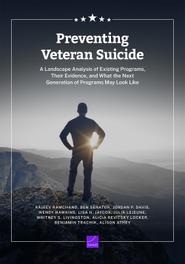Preventing Veteran Suicide
A Landscape Analysis of Existing Programs, Their Evidence, and What the Next Generation of Programs May Look Like
ResearchPublished Apr 16, 2025
In this report, the authors analyze current and emerging activities to prevent veteran suicide. They introduce the RAND Suicide Prevention Activity Matrix, a framework that organizes current approaches, how they complement each other, how they might change, their evidence for preventing veteran suicide, and why they might (or might not) work. The authors then provide recommendations for organizations that implement suicide prevention strategies.
A Landscape Analysis of Existing Programs, Their Evidence, and What the Next Generation of Programs May Look Like
ResearchPublished Apr 16, 2025

Preventing veteran suicide is a national priority for government, veteran advocacy groups, and the private sector. This attention has led many individuals and organizations to leverage their expertise to create, expand, or promote activities that they hope will prevent future deaths. While the number and array of diverse approaches reflect a nation committed to a common goal, they also can create confusion. Advances in technology also generate questions about the future of veteran suicide prevention.
In this report, the authors analyze current and emerging activities to prevent veteran suicide. They introduce the RAND Suicide Prevention Activity Matrix, a framework that organizes current approaches, how they complement each other, how they might change, their evidence for preventing veteran suicide, and why they might (or might not) work. This framework places 26 categories of activities in a matrix based on whom the activity targets (the veteran directly, those who regularly interact with the veteran, or social influences) and what the activity is intended to accomplish (address social conditions, promote general well-being, address mental health symptoms, provide mental health supports, and prevent suicide crises). Entities committed to preventing veteran suicide and seeking to design evidence-informed, comprehensive suicide prevention strategies will benefit from the framework and evidence reviewed in this report, in addition to the recommendations the authors developed from these data.
This research was funded through a generous grant from Face the Fight© Charitable Fund and conducted within the RAND Epstein Family Veterans Policy Research Institute.
This publication is part of the RAND research report series. Research reports present research findings and objective analysis that address the challenges facing the public and private sectors. All RAND research reports undergo rigorous peer review to ensure high standards for research quality and objectivity.
This document and trademark(s) contained herein are protected by law. This representation of RAND intellectual property is provided for noncommercial use only. Unauthorized posting of this publication online is prohibited; linking directly to this product page is encouraged. Permission is required from RAND to reproduce, or reuse in another form, any of its research documents for commercial purposes. For information on reprint and reuse permissions, please visit www.rand.org/pubs/permissions.
RAND is a nonprofit institution that helps improve policy and decisionmaking through research and analysis. RAND's publications do not necessarily reflect the opinions of its research clients and sponsors.